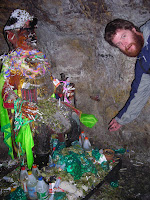



We continued our adventures into 2010 with a trip to Bolivia's most important archaeological site, Tiwanaku, set on a barren plane 70km from La Paz. Tiwanaku was the cradle of Andean civilisation, first established in 1,000 B.C. The museum contained some interesting exhibits including trepanned skulls, pottery and mummies. However, the Spanish have left virtually nothing of the treasures that this site once held and we were left somewhat disappointed following the archaeological marvels of the Sacred Valley in Peru.

Our last act in La Paz before heading south was to visit the witches market where we acquired a travelling good luck charm in the form of a small black ceramic llama. Hopefully, with his cheeky grin, he will serve us well!




We packed our llama and headed three hours south to Oruro, a run down tin mining town that has past its prime. Oruro is famous for its elaborate carnaval held in February involving fantastically over-the-top costumes, water-fights and crazy masks. We wandered down the street where the costumes were being made and were in awe of the craftmanship. It's a shame we won't be around to see the party in full swing! We also visited a neat little mining museum administered by nuns with the entrance located in the town's main church. After a steep descent into the mine we paid our respects to 'El Tio' (the Aymaran god of the underworld) by offering coca leaves and money. The mining museum was not the only unusual thing about the church, there were also dark and mysterious murals depicting the contrast between heaven and hell. There were definitely pagan overtones to this brand of Christianity and it was an interesting example of what happens when two sets of beliefs are merged into one.


Our first South American train journey took us from Oruro to the Southern town of Tupiza. We were extremely impressed by the level of comfort and 'bow-tie' service which put British trains to shame. I even got to enjoy a hot chicken dinner as we watched the sunset on the endless horizon of the Altiplano. We arrived in Tupiza to find a town that would not look out of place in a Western movie. The surrounding cactus strewn canyons and red pillars of rock are known as the 'badlands' of Bolivia and played host to the final shoot-out of Butch Cassidy and the Sundance Kid during a botched robbery in 1908.




Despite a childhood allergy, I thought this would be the perfect place to try horseback riding and fulfill my dreams of becoming a cowboy! To my amazement my reaction to the horses was minimal and before long I was cantering on the back of my trusty steed 'Gaucho'. It was an exhilarating moment and I felt truly free as we rode through the spectacular scenery.




After some delicious Argentine steaks and a few days by the pool we headed to Uyuni, a bleak desolate place with very little to recommend it apart from the convenience of booking a Salar de Uyuni tour. Indeed, the main highlight of the town (apart from leaving) was the train cemetery, choo choo. We found a sour, expensive gringo town so promptly got round to booking a tour. Due to the distances covered, lack of roads, wilderness and extremely cold nights, an organized 4x4 tour is pretty much the only way to see this vast area.


So first the bad news -The vehicle turned out to be a lemon, having lost its 122,000 km battle against the salt and rough roads. The food was barely adequate (with ketchup being the most exciting ingredient on offer) and the going tough on our backsides. We broke down about six times in three days and we spent 3 hours on day two amusing ourselves with an old mining tire in a sparrow fart town waiting for the 4x4 to be fixed!


On the plus side we saw some of the most startling scenery in our adventure so far. The salt flats were like an illusion and we took advantage of it to take some artistic shots. We also spent the night in a salt bed in a salt room in a salt hostel. It was interesting but very cold. We also met some wonderful Argentinians who were more than happy to help us with our Spanish.


Over the next few days we visted volcanoes, ogled flocks of flamingos, saw stunningly empty mineral stained lakes and basked in the isolation (apart from the 20 other 4x4´s on the circuit!)
We were also treated to a ´rock tree´and sightings of desert foxes, viscachas (Andean rabbit type creatures) and vicuña (wild realtive of the llama). On the last day we experienced the splendour of the Eduardo Avaroa nature reserve with its geysers, hotsprings and rugged moonscapes. When we got up at 3:30 am we were treated to the most amazing clear night carpeted with stars. The milky way was visible in its full splendour.








Following our southern Altiplano expedition, we now find ourselves in Potosi, the highest city in the world at 4100m! It has a tragic history that we will tell you all about next time.....
Ciao for now! Leon and Lydia



























